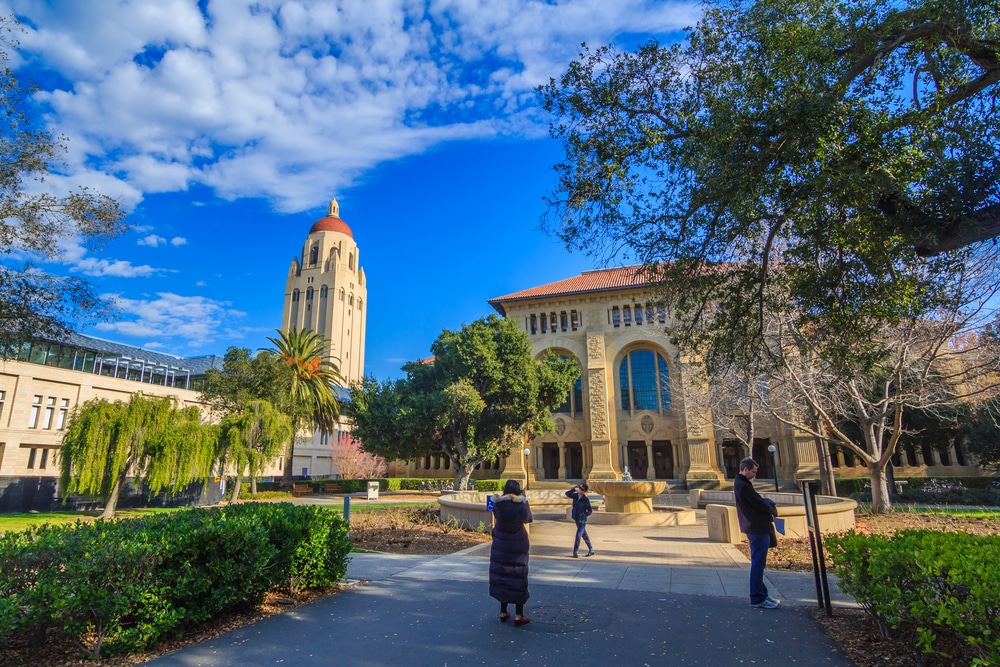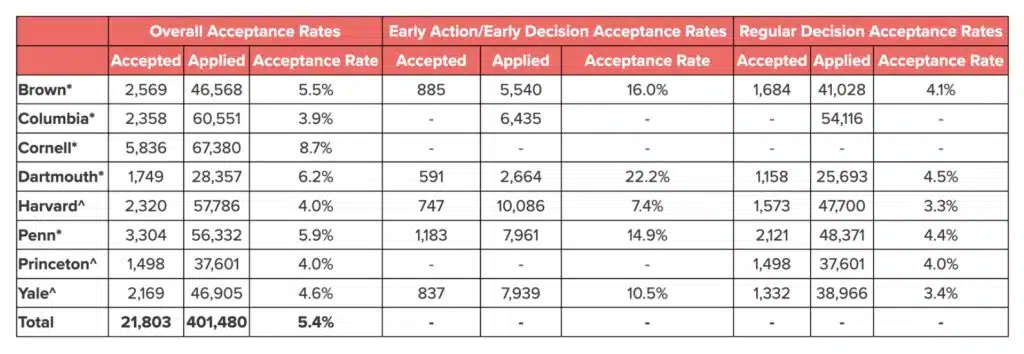When Do Stanford’s Decisions Come Out?
When it comes to colleges and universities that are the most prestigious and selective in the United States, many students often begin their search within the Ivy League.
While there is no doubt that the eight Ivy League schools are amongst the best in the entire world for both undergraduate and graduate students, there are also schools not in the Ivy League that are just as – if not more – prestigious.
One such school is Stanford University, located in Northern California. If you are interested in applying to Stanford, then chances are good that you are wondering when Stanford’s decisions come out.
If that is the case, then you have absolutely come to the right place! At AdmissionSight, we make it a top priority to be a well of information and knowledge for the high school students that we work with every application cycle.
Not only do we want to be able to help the students that we work with get into the schools of their dreams, we also want to help them figure out what those schools may be! That means that we have to know a lot about the application processes at all the top schools as well as what it is like going to one of those schools once a student actually gets in and enrolls.
That knowledge and expertise are two of the main reasons why 75 percent of the students that we work with end up getting into an Ivy League program or a top 10 school elsewhere in the United States, such as Stanford.
So, if you are a high school student who has set their sights on Stanford and want to learn more about the Stanford acceptance rate, the Stanford early acceptance date or about the Stanford waitlist decisions, then you have absolutely come to the right place! Let’s break all that down and more together.
The Stanford acceptance rate
When it comes to applying to Stanford University, it is important that every student applying keep in mind that this school is not only one of the hardest schools to get into in the United States, but also one of the hardest schools to get into in the entire world.
Without a doubt, students who end up getting rejected from Stanford can go on to get into schools like Harvard, Yale, Princeton and more, and it is quite possible that every single year, the admissions committee at Stanford has to end up rejecting deserving students.
There is no way to guarantee your acceptance to this kind of school, so it is simply your job to do everything within your power to prove to the admissions officers at the school that you belong and deserve a spot in the upcoming graduating class.
Because information is still rolling in when it comes to the most recent application cycle (the 2021-22 cycle), we thought it would make most sense to look back at the previous application cycle to get a better idea of where the Stanford acceptance rate sits at these days.
Before we go further it is important to make clear that school’s acceptance rates do change from year to year. With that being said, there are clear trends that schools follow and the rate does not usually rise or fall by more than a fraction of a percent from one year to the next. However, when looking at more long-view trends – say every five years or every 10 years – it becomes abundantly clear that the hardest schools to get into (such as Stanford, MIT or Columbia) have only gotten harder in recent years!
With that out of the way, let’s get into Stanford specifically.
Last year, Stanford received 55,471 applications for a spot in the Class of 2025; they accepted just 2,190. This acceptance rate of 3.95 percent was an all-time low for the university. For a historical perspective, the Class of 1978 had a 31 percent acceptance rate; the Class of 2011 was the last time the school had an acceptance rate in the double digits.
Here are some other important notes that students who are interested in applying to Stanford should know about the school’s graduating class of 2025.
- 18 percent of the Class of 2025 are first-generation students; down from 20 percent the previous cycle.
- 369 members of the Class of 2025 took a gap year after being admitted into the Class of 2024.
- The Class of 2025 was the largest in school history at 2,126 (including gap year students).
- The percentage of international students rose from 9.9 percent (Class of 2024) to 12 percent.
- The acceptance rate fell from 5.19 percent to 3.95 percent between the 2019-20 and 2020-21 admissions cycles.
So, now that you know about the specific numbers when it comes to the Stanford acceptance rate last year, you may be curious about how Stanford actually compares to the Ivy League in terms of difficulty to get in. For that reason, we thought we would break down the acceptance rates of all eight Ivy League schools. Take a look below:
As you can see from the table above, Stanford competes with even the most selective Ivy League schools. This is very important to keep in mind when applying to schools. Not all of your schools should be reached or “dream schools” like Stanford, Harvard or Columbia.
You should also make sure to apply to more realistic schools to get into, such as fantastic public schools with higher acceptance rates. This is not because you are planning to strike out on all your top choices, but rather because you can never predict what will happen in the application process. For that reason, make sure to do your due diligence and apply to a varied and diverse list of schools.
Important dates to know for Stanford decisions
So, when do Stanford’s decisions come out? Whether you are curious about learning about when you can expect a Stanford acceptance letter or when students need to make their decisions in the event that they are accepted, we’re covering all that and more.
There are a lot of reasons why it is important to know this kind of information. First of all, it gives students the information that they need to prepare themselves as best as possible for success. On top of that, knowing the answers to the questions like, “When do Stanford waitlist decisions come out?” or knowing the Stanford REA decision date will keep you from unnecessarily stressing in the weeks leading up to that time.
There is no point to worry about the result of your application in the weeks leading up to that actual decision being made. Instead, you can focus on more productive things like getting other applications in, continuing to excel in the classroom and continuing to commit your time and energy to activities that you care about!
So, with all that out of the way, let’s break down the important dates to know for Stanford decisions.
Freshman applicants:
| Application with Arts Portfolio | Restrictive Early Action
October 15 |
Regular Decision
December 5 |
| Materials for Arts Portfolio | October 20 | December 10 |
| Standard Application Deadline | November 1 | January 5 |
| Last Acceptable SAT Test Date | October | December |
| Last Acceptable ACT Test Date | September | December |
| Notification of Missing Documents | Mid-November | Mid-February |
| Decision Released By | December 15 | April 1 |
| Student Reply Date | May 2 | May 2 |
Transfer applicants:
| Application with or without optional Arts Portfolio Deadline | March 15 |
| Materials for Arts Portfolio Deadline | March 20 |
| Last Acceptable SAT Test Date | December |
| Last Acceptable ACT Test Date | February |
| Notification of Missing Documents | April |
| Decision Released By | May 15 |
| Student Reply Date | June 1 |
So, there you have it! Those are all of the key dates that students who apply to Stanford should keep in mind, both when it comes to when their applications are due as well as when they can start to expect to hear something back from the school. But just to make it clear we want to discuss…
When you can expect a Stanford acceptance letter
When it comes to getting an acceptance letter back from Stanford, the date in which you can get your response from the school depends entirely on how you chose to apply to Stanford. Of course, the two different forms of applications to Stanford are the REA or Restricted Early Action and the Regular Decision.
The Stanford REA decision date is released every year by December 15th and students have until May 2nd to reply to the school and either accept or reject their spot in the upcoming graduating class. It is important to know that while the Stanford REA does indeed have certain restrictions, students are not obligated to enroll if they apply in this manner.
The Stanford Regular Decision date is released every year by April 1st and students have until May 2nd to reply to the school and either accept or reject their spot in the upcoming graduating class.
With those dates in mind, it is important to remember that the decision that students hear back may not be that they were accepted or denied admission from the school. Another possibility is that students are waitlisted at the school.
But what does it mean to get waitlisted, when can students hear back about Stanford waitlist decisions and what should students do – if anything – to improve their chances of getting into Stanford once they have been waitlisted?
AdmissionSight has broken down the most common and important frequently asked questions regarding the Stanford waitlist decisions so you can know what to expect in the event that you get waitlisted at this school.
What does it mean to get waitlisted?
Getting on a highly competitive school’s waitlist is something that countless students have experienced through the years. But what does it really mean to get on a waitlist? Essentially, the waitlist is reserved for students who have all of the necessary qualifications to get into a school, but are not offered a spot of admission regardless. So, while a student who is waitlisted was not rejected from the school, they are also not able to get in – at least not yet.
Simply, the school needs more time to determine how many spots they have left to fill after all of the accepted students make their final decisions. For that reason, the number of students that end up getting in off a school’s waitlist can vary drastically from one year to the next.
Do you need to accept your place on the waitlist at Stanford?
It is very important for students to know that they have to officially accept their spot on the waitlist and submit the online Stanford Waitlist Response Form in order to be considered for future admission.
The school also welcomes brief updates to a student’s application using the same form. It is also important to note that these updates can only be submitted once. If students want to update their application profile later, they can do so using the Update Application function in their portal.
How many applicants are accepted off the waitlist?
Students who have been waitlisted at Stanford may not want to hear this, but it is important that they do so in order to remain realistic. Typically just 1.0 percent of students who are waitlisted at Stanford end up getting in. For that reason, it is really important that students who are waitlisted at Stanford make sure that they have a backup plan in the event that they become part of the 99.0 percent of waitlisted students who are ultimately not offered a spot of admission.
Is the waitlist ranked?
Some schools rank their waitlist in terms of students that will be accepted first if a spot opens up. So, if a student gets the first rank on a waitlist, they will be the first student accepted. Other schools have an unranked waitlist, which means that the school simply draws from a pool at random when a spot opens up.
At Stanford, the waitlist is unranked. This can work or not work in a student’s favor depending on how you look at it. Because it is unranked, and therefore quite random, it is important for students to think long and hard about whether or not they want to remain on the waitlist as opposed to simply accepted admissions at one of the other schools that they applied to and were accepted into.
When do students hear back about their Stanford waitlist decision?
The school re-evaluates waitlist candidates in the event that the number of enrolled students is lower than the available spots at the school. For that reason, waitlisted students are not even looked at until after the May 2nd decision date. From there, the school provides all candidates holding a space on the waitlist with a final decision by July 1st.
If I am rejected, will Stanford tell me why?
Sometimes, not knowing why you were not ultimately accepted by your dream school can be just as hard as not actually getting in. For that reason, a lot of students who are either rejected or not accepted off of the waitlist want to know the reason why. Unfortunately, that is not really a possibility.
All admission decisions at Stanford – and at every college or university in the United States for that matter – are made by a committee and not by any one admission officer. As a result, the school is unable to provide applicants with a specific or detailed reason for why they were not offered a spot at the school.
What to do if you are waitlisted
Once students are waitlisted, they are presented with a number of different opportunities. They can either accept or reject their waitlist spot and then they should start thinking about what other schools they may want to attend.
This is why applying to numerous schools – and a diverse list of schools when it comes to competitiveness – is the very best strategy for any student to take when applying to undergrad programs. Of course, every student wants to get accepted and go to their dream school, but that is not always the way things turn out. If you are ultimately rejected from Stanford off the waitlist, chances are good there are many fantastic schools that you were accepted by.
On the other hand, if you are determined to attend Stanford, you can delay your undergraduate education for a year and take a gap year to apply in the following application cycle. It is important to know that applicants are limited to a total of three applications for undergraduate admissions, whether for freshman admission, transfer admission or a combination of both.
Get more advice on Stanford admissions
There is no doubt that it is hard getting into Stanford. However, it is not at all impossible and students prove that fact every year. If you are interested in learning more about the application process at Stanford and how to improve your chances of getting accepted, contact AdmissionSight today for a free consultation.










































